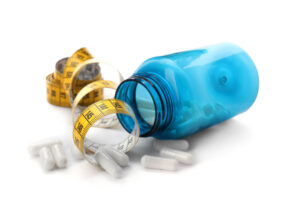Living with depression can be exhausting, but finding the right treatment for your symptoms shouldn’t be. Not everyone responds well to first-line treatments like selective serotonin reuptake inhibitors (SSRIs). In cases like this, finding effective treatment might mean turning to other antidepressants.
Tricyclic antidepressants like Doxepin and Amoxapine are sometimes prescribed to treat treatment-resistant depression when first-line depression medications don’t relieve depression symptoms.
In this post, we’ll explore and compare the tricyclic antidepressants Doxepin and Amoxapine to give you a better understanding of how tricyclic antidepressants work to treat depression.
We’ll cover—
- How these antidepressants and other tricyclic antidepressants work
- What mental health conditions these tricyclic antidepressants treat
- What are potential side effects, warnings, and potential interactions
- What are the forms, doses, and costs of each antidepressant
- Plus, some FAQs the mental health professionals on Klarity often receive.
If you need access to mental health medications to treat your treatment-resistant depression, Klarity can help.
Book an appointment, and we will connect you with a licensed healthcare professional who can diagnose and prescribe Doxepin, Amoxapine, and other tricyclic antidepressants within 48 hours.
| Amoxapine | Doxepin | |
|---|---|---|
| Drug Class | Tricyclic antidepressant |
Tricyclic antidepressant |
| Brand / Generic Status | Generic (Brand name: Asendin) |
Generic (Brand name: Silenor) |
| Form(s) of the Drug | Immediate-release color-coded tablets | • Immediate-release capsules • Immediate-release tablets • Clear, blueberry-mint flavored liquid suspension • Topical cream (for itching) |
| Standard Dosage | Immediate-release color-coded tablets: • 25mg: white • 50mg: orange • 100mg: blue • 150mg: light orange |
Immediate-release capsule: • 10mg • 25mg • 50mg • 75mg • 100mg • 150mg Immediate-release tablets: • 3mg • 6mg Liquid suspension: • 10mg per dose Topical cream: • 5% formula |
| Conditions Treated | FDA-approved: • Depression with psychotic features • Nerve pain Off-label: • Difficulty sleeping |
FDA-approved uses: • Major depressive disorder • Anxiety disorder • OCD Off-label uses: • Itchiness due to atopic dermatitis, pruritus, or lichen simplex chronicus • Topical neuropathic pain |
| Cost | Generic (amoxapine): • $20 to $36 for a 30-day supply Brand name: • Brand name formula not available for Rx |
Brand name (Silenor): • $32 to $525 for a 30-day supply Generic form (doxepin) • $36 to $90 for a 30-day supply • $8 for a 30-day supply with coupons/discounts |
| Side-Effects | Common side effects: • Sedation or drowsiness • Dry mouth • Constipation, nausea • Fatigue or weakness • Blurred vision • Anxiety or restlessness • Insomnia or difficulty sleeping • Confusion or altered consciousness • Palpitations or changes in EKG patterns • Tremors • Increased appetite causing changes in weight over time Serious side effects • Signs of Neuroleptic • Malignant Syndrome (NMS) • Serotonin syndrome • Increased suicidal thoughts or self-harm behaviors |
Common side effects: • Agitation, confusion • Black, tarry stools, bleeding gums, blood in urine or stool • Blurred vision • A sensation of burning, itching, or “pins and needles” on the skin • Chest pain or tightness, fast or irregular heartbeat • Chills, cold sweats • Urinary retention • Dizziness upon standing, loss of consciousness • Headache • Hearing loss • Muscle spasms, stiffness, twitching • Seizures |
| Warnings For Use | Drug interactions • Other anticholinergic medications • Blood pressure medication • Alcohol and barbiturates • MAOIs • SSRIs • Thyroid supplements |
Drug interactions: • Thyroid supplements • Anticholinergic drugs • Some blood pressure medications: clonidine • MAO inhibitors: isocarboxazid, linezolid, metaxalone, methylene blue • SSRIs • St. John's Wort • Cimetidine • Terbinafine • Drugs to treat irregular heart rate |
Doxepin and Amoxapine Are the Same Class of Drugs (Tricyclics)
Tricyclic antidepressants (TCA) are one class of medications that are used to treat depression and anxiety. TCAs are among some of the oldest type of antidepressants.
Doxepin and Amoxapine are both TCA medications, and they share a similar mechanism of action, however, there are key differences between them which will be discussed below.
What Are Tricyclics?
Tricyclic antidepressants are a large group of drugs that work to improve mood by blocking the reuptake of two important neurotransmitters, serotonin, and norepinephrine, within the brain. The majority of antidepressant medications work to increase the levels of these neurotransmitters, which are responsible for several important functions, including sleep, appetite, mood, and sex drive, to name a few.
Doxepin and Amoxapine Are Both Used To Treat Major Depressive Disorder
Doxepin and Amoxapine are two TCA medications that are useful in the treatment of depressive disorders. Depression presents itself differently from person to person but is commonly associated with persistent depressed mood and loss of interest in normally pleasurable activities.
Some other common symptoms of depression include:
- Feelings of helplessness, hopelessness, or guilt
- Increased irritability
- Changes in appetite, which may result in weight loss or gain
- Sleep disturbances, such as insomnia or increased need for sleep
- Thoughts of self-harm or suicidal ideation
What Else Does Doxepin Treat?
Doxepin is also known as Silenor and is most commonly used to treat anxiety and depression. Doxepin is available in a topical formulary for the treatment of itching in certain dermatological conditions, such as eczema. Like most medications, there are some “off-label” uses for this medication, listed below.
Off-label Uses for Doxepin
The term “off-label” is used to describe any use for a medication that is not FDA-approved. This does not mean that the medication is not useful in treating a specific condition but simply has not gone through the lengthy research process for FDA approval.
Some off-label uses for Doxepin or Silenor include insomnia and certain chronic pain conditions, such as neuropathic or nerve pain.
What Else Does Amoxapine Treat?
Amoxapine is also known by its brand name Asendin and is also useful in the treatment of depression and anxiety disorders.
Amoxapine is unique when compared to other TCA medications because, along with serotonin and norepinephrine, it also affects a neurotransmitter called dopamine. Due to this feature, Amoxapine or Asendin is also useful for treating depression with psychotic features.
Off-label Uses for Amoxapine
As previously mentioned, the term “off-label” refers to the use of medication outside of its FDA-approved medication use. The FDA approval process is lengthy and requires a lot of resources and time, which prevents drug companies from gaining FDA approval for every use.
Some off-label uses for Amoxapine include insomnia and chronic neuropathic or nerve pain.
Doses, Dosage Form, and Side Effects of Amoxapine
Common Amoxapine Doses and Forms
Amoxapine is available as a tablet in both name-brand and generic equivalents. The medication is typically started at a low dose of 25-50 mg and can be increased weekly to the targeted dose. The maximum daily dose of Amoxapine is 400 mg per day and 600 mg per day in those who are in a hospital setting with close monitoring.
Amoxapine tablets are available in the following dosages:
- 25 mg
- 50 mg
- 100 mg
- 150 mg
Common Amoxapine Side Effects
As with any medication, there is a risk of developing side effects after starting the medication. It is important to note that all TCA medications should be used with caution in the elderly population over the age of 65 years, including Amoxapine. Some potential adverse effects in this age group include sedation which may result in falls or injury, a dangerous drop in blood pressure, and hyponatremia or low sodium levels.
The most common side effects of Amoxapine include:
- Sedation or drowsiness
- GI upset, including nausea, vomiting, diarrhea, or constipation
- Dry mouth
- Fatigue
- Weakness
- Increased anxiety or restlessness
- Insomnia or difficulty sleeping
- Increased appetite, which may result in weight gain over time
Serious side effects include:
- Blurred vision
- Tremor
- Confusion or an altered consciousness
- Palpitations, arrhythmias, or changes in EKG patterns
If you begin to experience any of the serious side effects, it is important to discontinue the medication and contact your healthcare provider immediately.
Common Amoxapine Drug Interactions With Other Medications
When starting a new medication, it is important to disclose all medication you are currently taking with your healthcare provider, including all over-the-counter medications and supplements.
Some common interactions seen with Amoxapine include:
- Anticholinergic medications, including Atropine
- Certain medications for high blood pressure, such as clonidine
- MAOI medications, including isocarboxazid, linezolid, methylene blue, or phenelzine, to name a few
- SSRIs
- Thyroid supplements
- CNS depressants, such as alcohol, benzodiazepines, and barbiturates
How Much Does Amoxapine Cost?
The cost of your monthly supply of medication will vary depending on your insurance coverage, which dose you are on, and what pharmacy you use. Amoxapine is typically covered by the majority of insurance plans.
For those without insurance, the use of coupon codes can save you nearly 50% of the cost of your monthly supply of medication. Coupons can be found at most large pharmacies and reduce the cost of your Amoxapine prescription from its average retail price of $42 to around $20 for a 30-day supply.
Doses, Dosage Form, and Side Effects of Doxepin
Common Doxepin Doses and Forms
Doxepin or Silenor is available in capsule, tablet forms, and as an oral solution or topical cream. The oral solution is typically reserved for those who are unable to swallow a pill and is available in 10 mg/mL dosing only.
Doxepin capsules are available in the dosages:
- 10 mg
- 25 mg
- 50 mg
- 75 mg
- 100 mg
- 150 mg
Doxepin tablets are available in the dosage forms:
- 3 mg
- 6 mg
Doxepin is typically started at a low dose of 75 mg once daily and can then be titrated up weekly to a maximum dose of 150 mg per day.
Common Doxepin Side Effects
Like all medications, there is a risk of developing side effects, which should be kept in mind when starting Doxepin. If you develop serious or bothersome side effects while taking Doxepin, contact your healthcare provider or seek out immediate medical care.
Some of the common side effects associated with Doxepin include:
- Agitation or confusion
- Chills or cold sweats
- Headache
- A sensation of burning, itching, or “pins and needles” on the skin
- Dizziness upon standing
- Muscle spasms, stiffness, twitching
Serious side effects of Doxepin include:
- Signs of easy bruising or bleeding, including black or tarry stools or blood in the urine or stool
- Chest pain or tightness
- Fast or irregular heartbeat
- Blurred vision
- Hearing loss
- Seizures
- Loss of consciousness
Common Doxepin Interactions With Other Medications
As always, it is important to discuss all medications, including over-the-counter medications and supplements, with your healthcare provider before starting a new medication.
Common drug interactions with Doxepin include:
- Anticholinergic drugs
- MAOI medications, including isocarboxazid, linezolid, or methylene blue
- SSRIs
- Thyroid supplements
- Certain antihypertensive medications, such as clonidine
- Antifungal medications, like Terbinafine
- Antiarrhythmic medications or drugs that treat irregular heart rate
- St. John’s Wort
How Much Does Doxepin Cost?
The cost of your monthly prescription of Doxepin will depend on several factors, including your insurance coverage, dosing, and which pharmacy you use. Doxepin is relatively affordable for those who are uninsured with the use of coupon codes.
Coupons can be found at large name-brand pharmacies and significantly lower the monthly cost of your Doxepin prescription from its average retail price of $50 to less than $10 for a 30-day supply of medication.
Do I Need A Prescription for Doxepin or Amoxapine?
Yes, Doxepin, Amoxapine, and other tricyclic antidepressants are prescription medications that need to be written by a licensed healthcare professional. As mentioned above, TCA medications are associated with many serious side effects and drug interactions, which make these medications not ideal for everyone. Your healthcare provider will determine if a TCA medication may be beneficial for you and will prescribe it accordingly.
Other Tricyclic Side Effects
Tricyclic antidepressants have become less popular over the past couple of decades due to their side effect profile and the availability of safer and more effective medications. There are a few serious side effects shared among all TCA medications, and they should be closely monitored when starting a new drug.
What is Serotonin Syndrome?
Serotonin syndrome is a rare but serious and potentially life-threatening condition that may occur when starting a TCA medication. This condition occurs when there is a dangerously high level of serotonin in the body and most commonly occurs when someone is taking more than one medication that increases the level of serotonin in the body.
It is important to contact your healthcare provider or seek immediate medical attention if you begin to experience any of the following signs of serotonin syndrome:
- Agitation or restlessness
- Insomnia
- Confusion or altered consciousness
- Increased heart rate
- Increased blood pressure
- Vomiting, diarrhea
- Fever
- Increased sweating
- Vasomotor Symptoms
- Muscle twitching or rigidity
- Involuntary movements or tremors
- Exaggerated reflexes
- Seizures
Pregnancy and Breastfeeding on Tricyclics
Tricyclic antidepressants should typically be avoided during pregnancy due to the following potential complications:
- Spontaneous abortion or loss of pregnancy
- High blood pressure or preeclampsia
- Preterm birth
- Postpartum hemorrhage
- Postnatal effects include withdrawal symptoms, hypoglycemia, jaundice, or decreased respiratory drive
Your healthcare provider can provide alternative medications that are considered safe to take during pregnancy for the treatment of depression and anxiety. In addition, they will safely taper you off of your TCA medication and restart you on your new medication, as well as provide close monitoring throughout your pregnancy.
Breastfeeding while on a TCA medication is generally viewed as safe for the infant because there are relatively low levels of the drug found within breast milk. Of note, Doxepin should be avoided by those who are breastfeeding due to its long half-life.
Increased Bleeding Risk When Combining Tricyclics and Warfarin
TCAs do not appear to increase bleeding risk when used alone. This is unlike other antidepressants, such as SSRIs, which have a significantly increased bleeding risk, especially when used with over-the-counter pain relievers.
TCAs prevent Warfarin metabolism and breakdown in the body. When taking both medications simultaneously, there could potentially be an increased risk of bleeding due to increased levels of Warfarin.
Signs and symptoms of bleeding include:
- Black or tarry stools
- Blood in stool or urine
- Severe abdominal pain
- Easy bruising
- Bleeding gums when brushing your teeth
Black Box Warning With Antidepressants
As with most antidepressant medications, there is a potential risk for increased depression after starting the medication, which may increase suicidal thoughts or self-harm behaviors.
These suicidal thoughts and feelings are most common in those under the age of 24 years old. Although this is a fairly rare occurrence, it is important that you monitor yourself for negative changes in mood or increased or new suicidal ideation when starting any antidepressant.
Licensed providers on Klarity provide personalized treatment. Find a provider that matches your needs and preferences.
Amoxapine and Doxepin Frequently Asked Questions
Learning about the different antidepressants can be confusing, especially when comparing drugs from the same class of medications. We went over a lot of information, and you may be left with additional questions. Below we have answered some of the most common questions on Amoxapine vs. Doxepin.
What is Amoxapine?
Amoxapine is a tricyclic antidepressant that is used to treat anxiety, depression, and neuropathic pain. Amoxapine is unique among the class of TCAs due to its additional effects on dopamine and, therefore, can be useful in the treatment of depression with psychotic features.
What is Doxepin?
Doxepin is also a tricyclic antidepressant that is commonly used to treat anxiety, depression, and itching associated with hives or certain dermatological conditions, such as eczema.
Are Amoxapine and Doxepin the same drug?
Although both Amoxapine and Doxepin belong to the same class of medications called tricyclic antidepressants and share a similar mechanism of action, they have unique differences and are considered different drugs.
Is Amoxapine an off-label treatment for anxiety?
Amoxapine is considered off-label use for anxiety because other medications are more effective and safer to take for anxiety with a mild side effect profile.
What’s better for depression? Amoxapine or Doxepin?
Both Amoxapine and Doxepin are useful in the treatment of depression but are not considered first-line treatment for depression because TCA medications are associated with many side effects, and there are safer, more effective medications on the market.
Although, some people are unable to tolerate first-line medications due to drug interactions, comorbidities, bothersome or serious side effects, or simply because they are ineffective in treating their symptoms. Therefore, there are many circumstances where TCA medications are the best or most effective treatment for the individual.
When comparing the two medications, Amoxapine is more effective in treating more severe forms of depression, including depression with psychotic features.
Can I drive on antidepressants like Amoxapine or Doxepin?
You should avoid operating heavy machinery and driving when taking either Amoxapine or Doxepin until you are aware of how the medication affects you. This is due to the sedating effects associated with both medications.
Can I drink alcohol on Amoxapine or Doxepin?
No, you should avoid all CNS depressant substances while taking Amoxapine or Doxepin, including alcohol, benzodiazepines, or barbiturates. When combining these substances, there is an increased risk of developing side effects or sedating effects, which may result in injury.
Does it matter what time of day I take Amoxapine or Doxepin?
Amoxapine is typically taken multiple times a day, while Doxepin is typically prescribed once at night before bed due to its sedative effects. Your healthcare provider will instruct you on how to take your medication, and it is important to take your medication as prescribed.
How Klarity Helps You Access Depression Treatment Fast
You don’t have to wait weeks to get the proper treatment for your treatment-resistant depression or a variety of other mental health conditions. Instead of wasting time on a waitlist or enduring your symptoms for an appointment weeks out, Klarity can connect you with a board-certified mental health professional in 48 hours or less.
Book your first appointment on Klarity today.
Sources:
“Amoxapine” GoodRx. https://www.goodrx.com/amoxapine
“Amoxapine: Drug Information” UpToDate. https://www.uptodate.com/contents/search?search=amoxapine&sp=0&searchType=PLAIN_TEXT&source=USER_INPUT&searchControl=TOP_PULLDOWN&searchOffset=1&autoComplete=false&language=&max=0&index=&autoCompleteTerm=&rawSentence=
“Amoxapine Prices, Coupons, and Patient Assistance Programs” Drugs.com. https://www.drugs.com/price-guide/amoxapine#:~:text=The%20cost%20for%20amoxapine%20oral,accepted%20at%20most%20U.S.%20pharmacies.
“Compare Amoxapine vs. Doxepin” Iodine. https://www.iodine.com/compare/amoxapine-vs-doxepin
“Doxepin” GoodRx. https://www.goodrx.com/doxepin?dosage=75mg&form=capsule&label_override=doxepin&quantity=30&sort_type=popularity
“Doxepin: Drug Information” UpToDate. https://www.uptodate.com/contents/doxepin-systemic-drug-information?search=doxepin%20uses&source=search_result&selectedTitle=1~150&usage_type=default&display_rank=1&showDrugLabel=true#F8082233
“Doxepin Prices, Coupons and Patient Assistance Programs” Drugs.com. https://www.drugs.com/price-guide/doxepin







